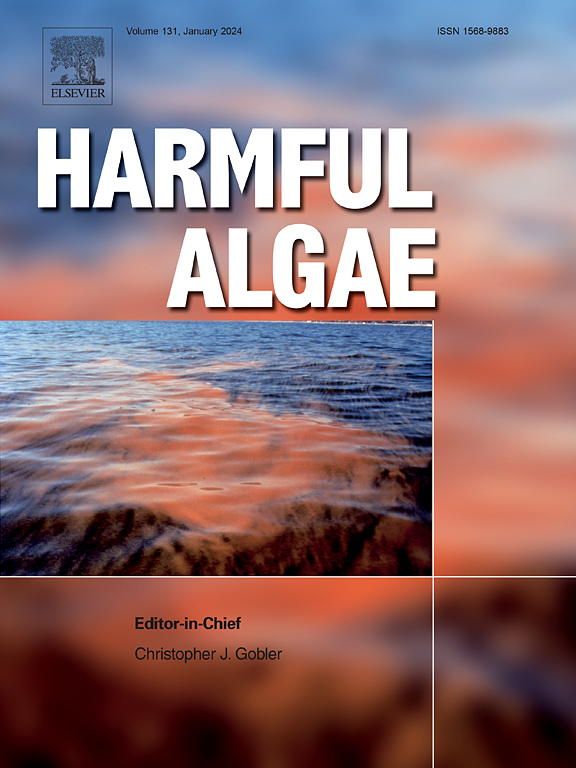Phytoplankton assemblage structure, drivers, and thresholds with a focus on harmful algal bloom ecology in the Lake Okeechobee system, Florida, USA
IF 5.5
1区 生物学
Q1 MARINE & FRESHWATER BIOLOGY
引用次数: 0
Abstract
Untangling the complexities of harmful algal bloom (HAB) dynamics is an ongoing effort that requires a fundamental understanding of spatiotemporal phytoplankton patterns and the environmental filters through which assemblages are structured. To this aim, monthly field surveys were conducted from 2019 to 2021 at 21 sites in Lake Okeechobee, Florida – a large, shallow, eutrophic, and heavily managed lake with coastal connectivity that experiences intense and recurrent HABs. Phytoplankton assemblages were strongly spatially structured forming 7 distinct lake zones with significant dissimilarity in composition and total abundance. While successional patterns were not apparent across seasons or wet/dry periods, total phytoplankton abundance was significantly greater towards the end of the wet season. Distance-based linear models using 16 abiotic variables were used to identify significant explanatory variables of spatial and temporal patterns. The spatial model explained 93 % of the variability suggesting deterministic processes largely control spatial patterns. The temporal model explained only 48 % of the temporal variability suggesting stochasticity in lake-wide shifts in assemblages over time. However, the strong spatial structuring of assemblages may preclude lake-wide succession patterns. Total algal abundance metrics were inversely related to nitrate, orthophosphate, and total alkalinity, the strongest explanatory variables of assemblage patterns, suggesting a lag between peak resources and peak abundance as phytoplankton cycle “boom-to-bust” phases. Consistent with this inverse relationship, Threshold Indicator Taxa Analysis returned almost exclusively negative responder indicator taxa for all three explanatory variable gradients. The assemblage-level threshold defined the gradient boundary between boom- and bust-associated indicator taxa. These data contribute novel information about HABs ecology pertinent to management strategies.

美国佛罗里达州奥基乔比湖系统浮游植物组合结构、驱动因素和阈值——以有害藻华生态为重点
解开有害藻华(HAB)动力学的复杂性是一项持续的努力,需要对浮游植物的时空模式和环境过滤器的基本理解,通过这些过滤器构建组合。为此,从2019年到2021年,在佛罗里达州奥基乔比湖的21个地点进行了月度实地调查。奥基乔比湖是一个大型、浅水、富营养化、管理严格的湖泊,与海岸相连,经历了强烈和反复发生的赤潮。浮游植物组合具有强烈的空间结构,形成7个不同的湖区,在组成和总丰度上存在显著差异。虽然不同季节或干湿期的演替模式不明显,但总浮游植物丰度在雨季结束时显著增加。采用基于距离的线性模型,利用16个非生物变量识别时空格局的重要解释变量。空间模型解释了93% %的变异,表明确定性过程在很大程度上控制了空间模式。时间模型只解释了48% %的时间变异性,这表明随着时间的推移,整个湖泊的组合变化具有随机性。然而,组合的强烈空间结构可能会妨碍整个湖泊的演替模式。总藻类丰度指标与硝酸盐、正磷酸盐和总碱度呈负相关,而硝酸盐、正磷酸盐和总碱度是组合模式的最强解释变量,这表明在浮游植物周期的“繁荣到萧条”阶段,峰值资源和峰值丰度之间存在滞后。与这种反比关系一致,阈值指标分类群分析在所有三个解释变量梯度下几乎都返回负响应指标分类群。组合水平阈值定义了繁荣与萧条相关指示分类群之间的梯度边界。这些数据提供了与管理策略相关的关于有害藻华生态学的新信息。
本文章由计算机程序翻译,如有差异,请以英文原文为准。
求助全文
约1分钟内获得全文
求助全文
来源期刊

Harmful Algae
生物-海洋与淡水生物学
CiteScore
12.50
自引率
15.20%
发文量
122
审稿时长
7.5 months
期刊介绍:
This journal provides a forum to promote knowledge of harmful microalgae and macroalgae, including cyanobacteria, as well as monitoring, management and control of these organisms.
 求助内容:
求助内容: 应助结果提醒方式:
应助结果提醒方式:


